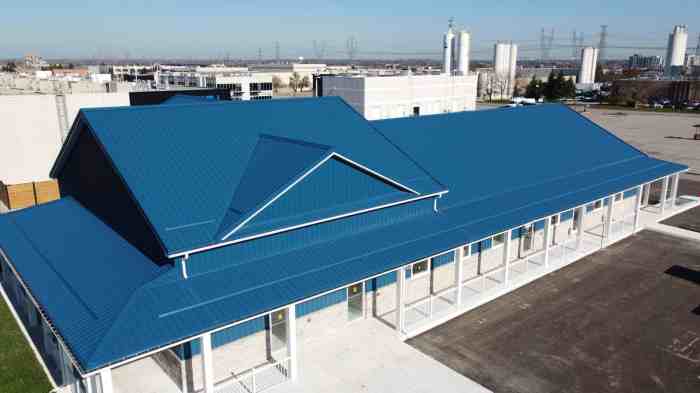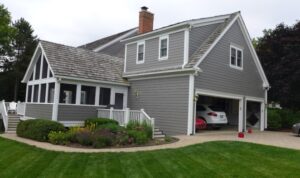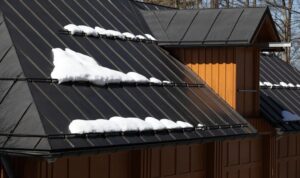Exploring the best roofing options for commercial buildings opens up a world of possibilities and considerations. From durability to cost-effectiveness, this guide delves into the key factors that can help you make an informed decision for your commercial property.
Types of Roofing Materials
When it comes to roofing materials for commercial buildings, there are several options available, each with its own set of benefits and considerations. Let's take a closer look at some of the most popular types of roofing materials used in commercial construction.
Metal Roofing
Metal roofing is known for its durability and longevity, making it a popular choice for commercial buildings. It is resistant to fire, rot, and insect damage, making it a low-maintenance option. While the initial cost of metal roofing may be higher than other materials, its long lifespan and energy efficiency can make it a cost-effective choice in the long run.
Some well-known commercial buildings with metal roofing include the Empire State Building in New York City and the Mercedes-Benz Superdome in New Orleans.
EPDM Roofing
EPDM (Ethylene Propylene Diene Terpolymer) roofing is a synthetic rubber membrane that is commonly used in commercial roofing applications. It is known for its durability, weather resistance, and ease of installation. While EPDM roofing is cost-effective initially, it may require more maintenance over time compared to other materials.
Some examples of commercial buildings with EPDM roofing include the Target Center in Minneapolis and the Barclays Center in Brooklyn.
TPO Roofing
Thermoplastic Polyolefin (TPO) roofing is a popular choice for commercial buildings due to its energy efficiency and ease of installation. TPO roofing is resistant to ozone, ultraviolet light, and chemical exposure, making it a durable option for commercial applications. While the initial cost of TPO roofing may be moderate, its long-term cost-effectiveness and energy efficiency make it a desirable choice for many commercial building owners.
Some notable commercial buildings with TPO roofing include the Staples Center in Los Angeles and the Toyota Center in Houston.
Built-Up Roofing
Built-Up Roofing (BUR) systems consist of multiple layers of roofing felt and bitumen, creating a durable and waterproof membrane. BUR roofing is known for its longevity and ability to withstand heavy foot traffic, making it a common choice for commercial buildings with high foot traffic or rooftop equipment.
While the initial cost of BUR roofing may be lower than other options, it may require more maintenance over time. Some well-known commercial buildings with BUR roofing include the Pentagon in Arlington and the Willis Tower in Chicago.
Environmental Impact
Choosing sustainable roofing options for commercial buildings can have a positive impact on the environment. These green roofing materials offer several advantages in terms of energy efficiency and environmental sustainability.
Energy Efficiency Benefits
- Green roofing materials such as solar panels or cool roofs can help reduce energy consumption by reflecting sunlight and reducing heat absorption.
- By lowering the energy needed for heating and cooling, green roofing materials can decrease greenhouse gas emissions and overall environmental impact.
LEED Certification Contribution
- Various roofing materials, such as recycled shingles or vegetative roofs, can contribute points towards LEED certification for commercial buildings.
- LEED certification recognizes sustainable building practices and encourages the use of environmentally friendly materials in construction projects.
Case Studies
- A commercial building in downtown Chicago implemented a green roof, reducing stormwater runoff and lowering energy costs for the tenants.
- In Los Angeles, a shopping center installed solar panels on its roof, generating renewable energy and reducing carbon emissions in the area.
Maintenance Considerations

When it comes to maintaining commercial roofing materials, regular upkeep is essential to prolong the lifespan of the roof and prevent any major issues. Different roofing materials have varying maintenance requirements, so it's important to understand how to care for each type properly.
Asphalt Shingles
- Regularly inspect for any damage, such as missing or cracked shingles.
- Clean gutters and downspouts to prevent water damage.
- Trim overhanging trees to prevent debris from accumulating on the roof.
- Check for signs of algae or moss growth and treat accordingly.
Metal Roofing
- Inspect for any loose or corroded panels and fasteners.
- Clean the roof surface to remove dirt and debris that can cause corrosion.
- Check for any signs of rust and apply a protective coating if necessary.
- Ensure proper drainage to prevent water ponding on the roof.
Single-Ply Membrane
- Regularly inspect seams and edges for any signs of damage or separation.
- Clean the membrane surface to remove dirt and debris that can cause punctures.
- Check for any signs of membrane shrinkage or blistering and address promptly.
- Ensure proper drainage to prevent water accumulation on the roof.
Tips for Prolonging Lifespan
- Schedule regular roof inspections at least twice a year, ideally in the spring and fall.
- Address any issues promptly to prevent them from escalating into major problems.
- Keep records of all maintenance and repairs for future reference.
- Work with a professional roofing contractor for complex maintenance tasks.
Installation Process
When it comes to installing roofing materials on commercial buildings, it is crucial to follow the correct procedures to ensure durability and longevity. Different types of roofing materials require specific installation methods, so it is essential to understand the process for each.
Metal Roofing Installation
Metal roofing systems are popular for commercial buildings due to their durability and longevity. The installation process for metal roofs typically involves the following steps:
- Preparing the roof surface by removing any old roofing materials and ensuring the surface is clean and smooth.
- Installing the underlayment to provide a waterproof barrier.
- Securing the metal panels or shingles in place, following the manufacturer's guidelines.
- Adding flashing and trim to ensure a watertight seal.
- Inspecting the roof for any gaps or issues before completing the installation.
PVC Roofing Installation
PVC roofing systems are known for their flexibility and resistance to chemicals and UV rays. The installation process for PVC roofs involves the following steps:
- Cleaning and preparing the roof surface.
- Rolling out the PVC membrane and securing it in place using adhesive or heat welding.
- Sealing the seams and edges to prevent leaks.
- Installing flashing and edge details for added protection.
- Conducting a thorough inspection to ensure the installation is done correctly.
Modified Bitumen Roofing Installation
Modified bitumen roofing systems are durable and easy to maintain. The installation process for modified bitumen roofs includes the following steps:
- Preparing the roof surface by cleaning and applying a primer.
- Rolling out the modified bitumen sheets and adhering them to the roof using heat or cold adhesives.
- Sealing the seams with heat or adhesives to prevent leaks.
- Adding a reflective coating for UV protection and energy efficiency.
- Inspecting the roof for any imperfections and ensuring proper installation.
Green Roof Installation
Green roofs are becoming increasingly popular for commercial buildings due to their environmental benefits. The installation process for a green roof involves the following steps:
- Structural analysis to determine if the building can support the weight of a green roof.
- Installing a waterproof membrane to protect the roof from water infiltration.
- Adding a drainage layer to ensure proper water management.
- Installing a growing medium and planting vegetation to create a green space.
- Maintaining the green roof regularly to ensure plant health and longevity.
Safety Measures and Precautions
When conducting roof installation projects on commercial buildings, it is essential to prioritize safety. Some key safety measures and precautions to follow include:
- Ensuring all workers are properly trained and equipped with the necessary safety gear.
- Implementing fall protection systems to prevent accidents and injuries.
- Securing ladders and scaffolding properly to avoid falls.
- Following proper lifting techniques to prevent strains and injuries.
- Checking weather conditions and avoiding installation during inclement weather.
Outcome Summary
In conclusion, choosing the right roofing material for your commercial building is crucial for its longevity and efficiency. By weighing the pros and cons of each option, you can ensure a sturdy and sustainable roof that meets your specific needs.
Common Queries
What is the most cost-effective roofing material for commercial buildings?
The most cost-effective roofing material for commercial buildings is EPDM due to its affordability and long-term durability.
How can I prolong the lifespan of my commercial roofing system?
To extend the lifespan of your commercial roofing system, regular inspections, prompt repairs, and proper maintenance are key.
Do green roofing materials contribute to LEED certification?
Yes, green roofing materials can contribute to LEED certification by enhancing energy efficiency and sustainability of the building.
What are some common issues that may arise with metal roofing systems?
Common issues with metal roofing systems include corrosion, leaks, and improper installation, which can be addressed through regular maintenance.






